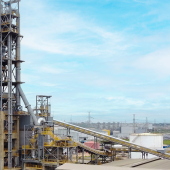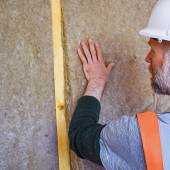Digital Twin

An extract from EYs white paper, co-authored by Todd Lukesh, Eric Ottinger ACABE, Nipun Bajaj, Jordan Stein, Erica Crandon, Mark Gibson and Akanksha Jain
A digital twin utilises spatial data to provide the core framework, equipment and engineering data to understand the systems and the internet of things (IoT) with sensors to capture real-time data. This enables the physical building to adapt to human needs, instead of the human conforming to the building’s limitations.
The aggregated data conducts simulations using physics-based modelling to run what if scenarios to optimise performance. Digital data is then able to deliver actionable insights geared toward efficiency while reducing wasted resources. A dynamic digital replica of the asset, or a virtual copy of the building, is finally created by collating the historical and live data feeds. Digital twins hold the potential to transform the built environment.
Until recently, gaining access to the right data that enables detailed insight of a building’s current and future state performance has been a challenge. Traditionally, static data was used to retrospectively measure how a building performs. However, advancements in artificial intelligence (AI), machine learning (ML), IoT, internet of ability (IoA) and cost-effective sensor technology have now made this possible. Combining these technologies with a digital twin has enabled information to be extracted in real time to efficiently analyse trends while incorporating impacts of external factors like weather conditions, occupancy scheduling, human impacts and resource allocation.
Progression of information
Digital twins have evolved since their onset and can be classified by various levels of complexity. Within the built environment, the digital twin begins at the component level and builds up to the process level.
- Component-level describes a digital twin of a component of an asset, such as a motor or a fan belt within a heating, ventilation, and air conditioning (HVAC) unit. Data from each component feeds into the larger asset to provide real-time visibility to its operating performance. Should that fan belt begin to fray, it informs the digital twin of the deficiency, and the data is then automatically routed as a work order to the maintenance team for repair. With advance notice provided by the digital twin’s pre-programmed alarm thresholds, a facility operator can take pre-emptive action to resolve the problem before it causes damage to other components or the asset.
- Asset-level is the most common version of a digital twin. It is a model of an entire asset, such as a piece of equipment, or a building, that continuously analyses real-time data to provide process improvements. With access to a digital twin of the asset, companies can experience similar benefits around preventive maintenance at an even broader scale.
- System-level is a digital model of a collection of assets that operate together systematically within a programme. A campus, portfolio of buildings and manufacturing plant could all benefit from a system-level digital twin. A digital twin of the system of assets allows management to view their portfolio from a holistic perspective to gauge how well the ecosystem of assets function together.
- Process-level digital twins provide a big-picture model and overarching framework to an organisation. They produce insight into the performance of the entire supply chain, rather than the operational model offered by a system or asset level digital twin. With process-level digital twins, companies can measure operational characteristics that align to their business strategy. A process twin focuses on optimising throughput, quality and other encompassing attributes of a company in relation to the market.
Environmental impact and sustainability
Solutions that reduce resource usage are increasing in value – not only for the cost savings opportunity, but due to the social responsibility to address climate change. By leveraging digital twins, IoT sensors and IoA augmentation, owners and facility managers can reduce a building’s environmental footprint by decreasing energy consumption from various components and systems.
These optimisation capabilities not only capture significant energy savings, but also enable companies with large carbon footprints to drastically reduce their emissions and global impact. Google’s Nest Learning Thermostat is an example that utilises IoT sensors paired with the building’s heating and cooling system. It detects the room’s temperature and humidity and programmes the HVAC system to adjust appropriately – in real time. By leveraging AI and ML, the thermostat identifies pattern recognition and desired spatial conditions on specified days and timeframes during the week, creating dynamic schedules for the HVAC system.
Another example where a digital twin was used to reduce energy consumption comes from Singapore’s Nanyang Technological University (NTU), a pioneer in academia for promoting smart technologies and infrastructure. NTU explored the use of digital twins to reduce its energy, water, carbon and waste across its campus of over 200 buildings.
Real-time data was analysed to uncover hidden energy and cost-saving opportunities across the various campus utilities. During the first five years of facility operations, Phase 1 analysis was performed as a preliminary investigation designed to extract high-level optimisation savings. It resulted in a 21% reduction in campus energy consumption, reduced 8.2 kiloton (kt) of its carbon emissions and provided S$3.9m (£2.1m) in cost savings during this timeframe.
Utilising Phase 1 information as a baseline, Phase 2 further drilled down on high-consumption utilities and collected data from a range of sources, including automated meter readings, utility bills, building management systems, IoT sensors and operational databases. The investigation involved deploying sub-hourly time-series data analyses and advanced analytics to identify additional energy and cost savings.
Saving costs and carbon
In the final stage, virtual digital twin models were created using data from Phase 1 and Phase 2 (a total of ten years) to compare the impact of installing a range of potential technologies. Through an iterative process of simulation analysis, the compelling results provided the university confidence in investing in five technologies that were projected to produce the greatest return on investment (ROI). Technologies included: high-resistance envelopes for walls and roofs, lighting with occupancy sensors, curtain wall upgrades, plug load management and high-performance optimised chillers. The adoption of these technologies reduced energy use by 31%, reduced 9.6kt of carbon emissions and provided S$4.7m of cost savings over the ten-year period, placing NTU on track toward achieving carbon neutrality.
Utilising historical and real-time data provides NTU the opportunity to forecast year-over-year savings, continuously optimising and fine-tuning building operations, resulting in additional ROI as time progresses.
Read the EY white paper in full at bit.ly/Digital_twin










